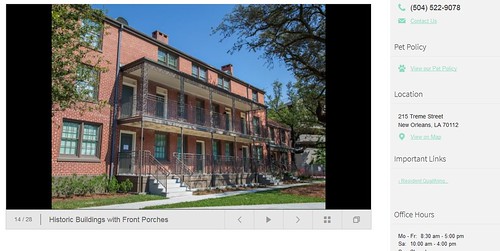The initial investment in Freret Street — the first new restaurants, the first abandoned homes restored for new families — was praised. But that success, forged largely by business owners with roots in the neighborhood, attracted increasing attention from others and now has a different feel.You have to love these anesthetized, hands to the air explanations. Welp, nothing to be done. Better to go with the flow. Because everyone knows that people and their lives are just grains of alluvium dispersed by the water. It's just inertia or gravity or whatever. No one ever thinks about guiding these events in any way.
"It's not just Freret Street that's changed a lot — it's five or six blocks on either side," Marvin said. "All that's changed. A lot of older black people who owned houses, they didn't come back. People just kept going in there and flipping [those houses]. It's not a bad thing, but older people just can't afford the property taxes anymore."
Campanella said he has observed that some housing prices appear to be reaching a plateau and increasing at a more natural, gradual rate. The pattern observed in areas like Freret, the Carrollton riverbend, Marigny and Bywater and Mid-City now is spreading to nearby neighborhoods, suggesting a future city that is wealthier at its core and poorer at its edges.
"I expect this to continue, although not necessarily at a constant rate," Campanella said. "Spatially, I predict it will spread into neighborhoods that are perceived to be historic, interesting, walkable, or otherwise culturally and structurally desireable, and adjacent to areas already seeing reinvestment, or that had never suffered divestment in the first place.
"On the urban and suburban periphery — that is, in New Orleans East, St. Bernard Parish, nearly all of the West Bank and most of East [Jefferson Parish] — housing remains relatively affordable if not flat-out cheap, compared to nationwide standards. This being the case, we should expect to see more of the trend that has been going on for a number of years: working-class and lower- to middle-class families shifting outwardly in a centrifugal pattern, while wealthier households, particularly young professionals and empty-nesters, moving inwardly in a centripedal shift."
Giving out rent vouchers as an alternative to building public housing projects has made a modest dent in the problem of densely concentrated poverty in the New Orleans metropolitan area, according to a new Data Center report.Okay well, sure, we did put some effort into escaping people from high-poverty neighborhoods. That the very buildings we helped them "escape" from are now being advertised as "Historic Buildings with Front Porches" is just a coincidence.
But the report’s authors, Stacy Seicshnaydre, of Tulane University Law School, and Ryan Albright, a doctoral fellow in urban studies at Tulane, point out that voucher recipients here are still far less likely to live in low-poverty neighborhoods than their peers elsewhere in the country.
They also found that black voucher recipients are less likely to live in low-poverty areas in New Orleans than their white counterparts.
The group recommends various steps to help low-income renters escape high-poverty neighborhoods, such as counseling, initiatives to combat racial discrimination by landlords and tax credits to expand the supply of affordable housing.
“The stakes are high for the low-income children in our region,” the report concludes. “The housing voucher program must be used to its fullest potential — assisting the next generation of New Orleans children to overcome the life-altering effects of poverty.”

Funny thing about "escaping high-poverty neighborhoods," though. It's different from actually escaping poverty.
For all the destruction and lives lost or permanently altered, there's a broad consensus that the city works better and offers greater opportunity than it did before the storm. Local governance is more responsive and seems to be less corrupt.That tends to follow people around... even as they "shift outwardly in a centrifugal pattern" as Camapnella puts it. What do we do when it re-concentrates?
Yet many opportunities have been squandered. “We're proclaimed a 'new' New Orleans,” says Karen Gadbois, of the investigative-reporting website The Lens. Yet, she adds, “40 percent of children here live in poverty,” and high crime rates persist.
Today, federally issued housing vouchers are the primary tool that low-wage residents use to pay for homes. In theory, vouchers can be used to move into any unit on the private market. However, Seicshnaydre’s and Albright’s analysis of voucher use shows that they have not afforded poor New Orleanians better housing choices. A key section of their report reads:Here's the map produced by that Atlantic article. You can see a larger version in the original report at the Data Center site.
An examination of voucher households reported by HUD in 2010 reveals that 25 percent of the vouchers were used in 5 percent of the census tracts (4,279 total vouchers used in nine tracts). In each of these nine tracts, more than 300 vouchers were used, which is triple the amount that would be present if vouchers were evenly distributed across all tracts. The number of vouchers appearing in these tracts ranged from 318 to 843. Seven of the nine census tracts are located in New Orleans East; six of the nine tracts in this group are in high-poverty areasThe map below shows that the nine high-poverty/high-voucher household census tracts are in just two areas of the city.
Guess it's pretty much okay for high-poverty neighborhoods to sit out there in the East and in Algiers. Nobody needs to "escape" from there. Not until someone decides that's where we should put more nice things for rich people, anyway. Don't expect that to happen any time soon.

No comments:
Post a Comment